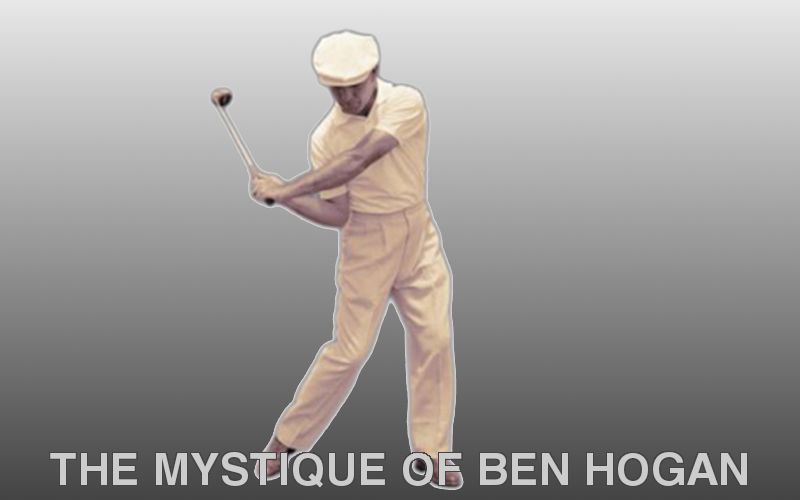The most striking image in the annals of golf instruction is of Ben Hogan addressing the ball with his head through a hole in a pane of glass. Hogan’s discussion of the plane has played a major role in golf instruction for forty years. In effect, he introduced a new way of looking at the swing. Every teacher discusses swing plane today; it would be unthinkable to ignore the subject.
A flat swing plane normally exaggerates a hooking problem by encouraging the club to move on an even shallower inside-to-out path when approaching the ball. This was very evident in Hogan’s case because when he made an actual swing, it was noticeable that the club was well “laid off,” or pointed to the left of the target at the top of his backswing. This laid-off look really accentuates an in-to-out swing for a good player who has a strong lower body move to start the downswing. As Hogan got older his backswing shortened – as happens with many players – and his club became even more laid off. This backswing, in combination with his speed of movement down and the late hit – where the clubhead lagged far behind the hands – still produced a hook at times, despite his swing changes and a weaker grip. As he wrote in 1955 in Life magazine, “I had a low, ducking, agonizing hook, the kind you can hang your coat on. When it caught the rough it was the terror of the field mice.”Through his perseverance he finally found a way to counteract and cure his hook. The answer was his “secret.”
Frustrated by his inability to find a solution while on the tournament trail, he packed his bags and went home. There, he all but isolated himself for a few days to think about things and see if he could come up with some ideas. After much thought and after wracking his brain, it suddenly came to him – a key that the old Scottish pros used. Hogan jumped up with excitement at his new discovery and the promise it offered, and went out to hit some balls. And lo and behold, it worked. He hit some soft, feathery fades, and instinctively knew he had it. He had found the cure. No matter how hard he hit the ball, it would not go left. “The harder I hit it,” Hogan said, “the better it worked. There was no loss of distance.”
The secret, in my opinion, was this:combined with his weak grip, Hogan focused on “cupping” his left wrist as he approached the top of his backswing; the cup was apparent in the Life magazine cover photograph. This “cupping” of the wrist in combination with rotating his left arm clockwise, in effect producing a real pronation of the wrist, got the toe of his club hanging down more to the ground and the face in a very open position, as opposed to a square position with the clubface looking more toward the sky. From this open position at the top, he was able to keep the clubface from being closed at impact, no matter how hard he rotated his left arm or tried to close the face coming down (a move that normally tends to shut the face excessively by the time the clubhead reaches the ball).
But why did he wait nearly a decade before letting the world in on his secret? The answer was simple, and he answered it straightforwardly. “Now that I am through with serious competition– – and I worked harder getting ready for this last Open (the 1955 U.S. Open) than any tournament in my life—I don’t mind letting the world in on my secret.”The open clubface meant that he was able, no matter how hard he hit the ball or how shallowly he came into it, to produce solid left-to-right softly-landing shots time after time. He stated that the cupping feeling at the top was one of his really conscious moves during the swing. For a draw he would just forget about the “cup” and swing normally, thereby keeping the left wrist fairly flat and the clubface much squarer (parallel to the wrist and forearm). This position produced a right-to-left ball flight.
The millions of golfers who waited patiently for his secret were probably disappointed, thinking that maybe Hogan’s secret would open the door for them to long-lasting great golf. However, Hogan held another secret. “I doubt if the secret will be worth anything to the weekend duffer and it will ruin a bad golfer,” Hogan later wrote. “With the clubface so wide open at the top of the backswing anybody who fails to close it properly on the way down will push the ball off to the right – or worse yet, shank it off to the right at a horrible right angle. But it will be a blessing to the good golfer.”Maybe this was the truly important secret:only better players should even think of trying it, while all others should ignore it.
Hogan’s secret of cupping the left wrist and getting the clubface more open would be absolutely ruinous for the slicing population who would give anything to hit a big hook and keep the ball out of the right-hand rough. Golfers who consistently slice the ball would only exacerbate their problem by trying to adopt the Hogan secret. However, that didn’t stop people who had read about the secret from turning themselves inside-out. I’ve talked to many golfers who tried the secret when he revealed it, only to experience nothing but frustration.
As one of the top golf instructors in the world, David Leadbetter is no stranger to innovation. In this excerpt from “The Fundamentals of Hogan” (Sleeping Bear Press), Leadbetter interprets Hogan’s “Five Lessons” from 1957, perhaps the finest golf instructional text ever written, with an eye for its value to the modern game.

